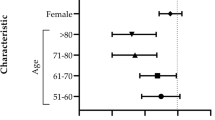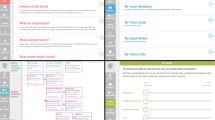Abstract
The majority of adults worldwide own a mobile phone, including those in under-resourced communities. Mobile health (mhealth) education technologies present a promising mechanism for improving cancer prevention, treatment, and follow-up. The purpose of this study was to summarize the literature related to mobile phone (mhealth) applications for patient education specific to cancer and identify current recommendations from randomized studies. In particular, we were interested in identifying mobile phone applications along the cancer continuum, from cancer prevention to survivorship. The authors identified 28 articles reporting on mobile applications for patients related to cancer. Articles were identified in all categories along the cancer continuum, including health professional involvement in application development. Of these, six involved direct patient education, and eight focused on improving patient/professional communication and patient self-management. However, only six of the studies were randomized interventions. The potential for mobile applications to help overcome the “health care gap” has not yet been realized in the studies from the USA that were reviewed for this paper. However, early recommendations are emerging that support the use of mHealth communications to change behaviors for cancer prevention, early detection, and symptom management and improved patient-provider communication. Recommendations include short messages, use of multiple modalities as patient characteristics dictate comfort with mHealth communication, and the inclusion of patients and health professionals to develop and test applications. Tailoring mHealth to particular cultures, languages, and ethnic groups may also represent a unique possibility to provide accessible information and education at minimal cost for under-resourced communities and individuals.
Similar content being viewed by others
References
International Telecommunication Union. 2012. Accessed 4 Oct 2013. http://www.ITU.int
Smith A (2011) Americans and their cell phones. Pew Internet & American Life Project, Washington, DC
Price M et al (2013) Hispanic migrant farm workers’ attitudes toward mobile phone-based telehealth for management of chronic health conditions. J Med Internet Res 15(4):e76
Dang CM et al (2013) Exploring potential use of internet, E-mail, and instant text messaging to promote breast health and mammogram use among immigrant Hispanic women in Los Angeles County. Am Surg 79(10):997–1000
Riley WT et al (2011) Health behavior models in the age of mobile interventions: are our theories up to the task? Transl Behav Med 1(1):53–71
Gustafson DH et al (2011) Explicating an evidence-based, theoretically informed, mobile technology-based system to improve outcomes for people in recovery for alcohol dependence. Subst Use Misuse 46(1):96–111
Hughes LD, Done J, Young A (2011) Not 2 old 2 TXT: there is potential to use email and SMS text message healthcare reminders for rheumatology patients up to 65 years old. Health Inform J 17(4):266–276
Fiordelli M, Diviani N, Schulz PJ (2013) Mapping mHealth research: a decade of evolution. J Med Internet Res 15(5):e95
Panayi ND, Mars MM, Burd R (2013) The promise of digital (mobile) health in cancer prevention and treatment. Future Oncol 9(5):613–617
Klasnja P, Pratt W (2012) Healthcare in the pocket: mapping the space of mobile-phone health interventions. J Biomed Inform 45(1):184–198
Vodopivec-Jamsek V et al (2012) Mobile phone messaging for preventive health care. Cochrane Database Syst Rev 12:CD007457
de Jongh T et al (2012) Mobile phone messaging for facilitating self-management of long-term illnesses. Cochrane Database Syst Rev 12:CD007459
Krishna S, Boren SA, Balas EA (2009) Healthcare via cell phones: a systematic review. Telemed J E Health 15(3):231–240
Free C et al (2013) The effectiveness of mobile-health technology-based health behaviour change or disease management interventions for health care consumers: a systematic review. PLoS Med 10(1):e1001362
Gurman TA, Rubin SE, Roess AA (2012) Effectiveness of mHealth behavior change communication interventions in developing countries: a systematic review of the literature. J Health Commun 17(Suppl 1):82–104
Bender JL et al (2013) A lot of action, but not in the right direction: systematic review and content analysis of smartphone applications for the prevention, detection, and management of cancer. J Med Internet Res 15(12):e287
King AC et al (2013) Harnessing different motivational frames via mobile phones to promote daily physical activity and reduce sedentary behavior in aging adults. PLoS One 8(4):e62613
Atienza AA et al (2006) Using electronic diaries to examine physical activity and other health behaviors of adults age 50+. J Aging Phys Act 14(2):192–202
Atienza AA et al (2008) Using hand-held computer technologies to improve dietary intake. Am J Prev Med 34(6):514–518
Gegg-Harrison T et al (2009) Porting a cancer treatment prediction to a mobile device. Conf Proc IEEE Eng Med Biol Soc 2009:6218–6221
Alipour S et al (2012) Comparison of teaching about breast cancer via mobile or traditional learning methods in gynecology residents. Asian Pac J Cancer Prev 13(9):4593–4595
Villani D et al (2012) The effects of a mobile stress management protocol on nurses working with cancer patients: a preliminary controlled study. Stud Health Technol Inform 173:524–528
Lana A et al (2013) Study protocol of a randomized controlled trial to improve cancer prevention behaviors in adolescents and adults using a web-based intervention supplemented with SMS. BMC Public Health 13:357
Greaney ML et al (2012) Electronic reminders for cancer prevention: factors associated with preference for automated voice reminders or text messages. Prev Med 55(2):151–154
Rosado L et al (2012) Extraction of ABCD rule features from skin lesions images with smartphone. Stud Health Technol Inform 177:242–247
Wadhawan T et al (2011) Implementation of the 7-point checklist for melanoma detection on smart handheld devices. Conf Proc IEEE Eng Med Biol Soc 2011:3180–3183
Tran K et al (2011) Mobile teledermatology in the developing world: implications of a feasibility study on 30 Egyptian patients with common skin diseases. J Am Acad Dermatol 64(2):302–309
Raza S, Sajun SZ, Selhorst CC (2012) Breast cancer in Pakistan: identifying local beliefs and knowledge. J Am Coll Radiol 9(8):571–577
Khokhar A (2009) Short text messages (SMS) as a reminder system for making working women from Delhi Breast Aware. Asian Pac J Cancer Prev 10(2):319–322
Lakkis NA et al (2011) The effect of two types of sms-texts on the uptake of screening mammogram: a randomized controlled trial. Prev Med 53(4–5):325–327
Kratzke C, Wilson S, Vilchis H (2013) Reaching rural women: breast cancer prevention information seeking behaviors and interest in Internet, cell phone, and text use. J Community Health 38(1):54–61
Quinley KE et al (2011) Use of mobile telemedicine for cervical cancer screening. J Telemed Telecare 17(4):203–209
Kivuti-Bitok LW et al (2013) An exploration of opportunities and challenges facing cervical cancer managers in Kenya. BMC Res Notes 6:136
Kreuter MW et al (2012) Small media and client reminders for colorectal cancer screening: current use and gap areas in CDC’s colorectal cancer control program. Prev Chronic Dis 9:E131
Wang S et al (2011) Integration of cell phone imaging with microchip ELISA to detect ovarian cancer HE4 biomarker in urine at the point-of-care. Lab Chip 11(20):3411–3418
Massone C et al (2009) Mobile teledermoscopy—melanoma diagnosis by one click? Semin Cutan Med Surg 28(3):203–205
Blake H (2008) Mobile phone technology in chronic disease management. Nurs Stand 23(12):43–46
Blake H (2008) Innovation in practice: mobile phone technology in patient care. Br J Commun Nurs 13(4):160, 162–5
Rao R et al (2012) Take two and text me in the morning: optimizing clinical time with a short messaging system. Plast Reconstr Surg 130(1):44–49
Klasnja P et al (2011) Supporting cancer patients’ unanchored health information management with mobile technology. AMIA Annu Symp Proc 2011:732–741
Odigie VI et al (2012) The mobile phone as a tool in improving cancer care in Nigeria. Psychooncology 21(3):332–335
Kearney N et al (2009) Evaluation of a mobile phone-based, advanced symptom management system (ASyMS) in the management of chemotherapy-related toxicity. Supp Care Cancer 17(4):437–444
McCann L et al (2009) Patients’ perceptions and experiences of using a mobile phone-based advanced symptom management system (ASyMS) to monitor and manage chemotherapy related toxicity. Eur J Cancer Care (Engl) 18(2):156–164
Larsen ME et al (2008) Chemotherapy side-effect management using mobile phones. Conf Proc IEEE Eng Med Biol Soc 2008:5152–5155
Weaver A et al (2007) Application of mobile phone technology for managing chemotherapy-associated side-effects. Ann Oncol 18(11):1887–1892
Lee MK et al (2013) Development and formative evaluation of a web-based self-management exercise and diet intervention program with tailored motivation and action planning for cancer survivors. JMIR Res Protoc 2(1):e11
O’Neill S, Brady RR (2012) Colorectal smartphone apps: opportunities and risks. Colorectal Dis 14(9):e530–e534
Maguire R et al (2008) Nurse’s perceptions and experiences of using of a mobile-phone-based advanced symptom management system (ASyMS) to monitor and manage chemotherapy-related toxicity. Eur J Oncol Nurs 12(4):380–386
Gibson F et al (2009) Involving health professionals in the development of an advanced symptom management system for young people: the ASyMS-YG study. Eur J Oncol Nurs 13(3):187–192
Acknowledgments
Funding for this work was provided through donations to CPIC and support to Dr. Oakley-Girvan’s investigator funds by the Stanford Cancer Institute.
Author information
Authors and Affiliations
Corresponding author
Rights and permissions
About this article
Cite this article
Davis, S.W., Oakley-Girvan, I. mHealth Education Applications Along the Cancer Continuum. J Canc Educ 30, 388–394 (2015). https://doi.org/10.1007/s13187-014-0761-4
Published:
Issue Date:
DOI: https://doi.org/10.1007/s13187-014-0761-4




